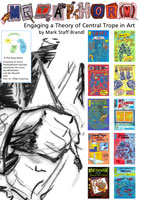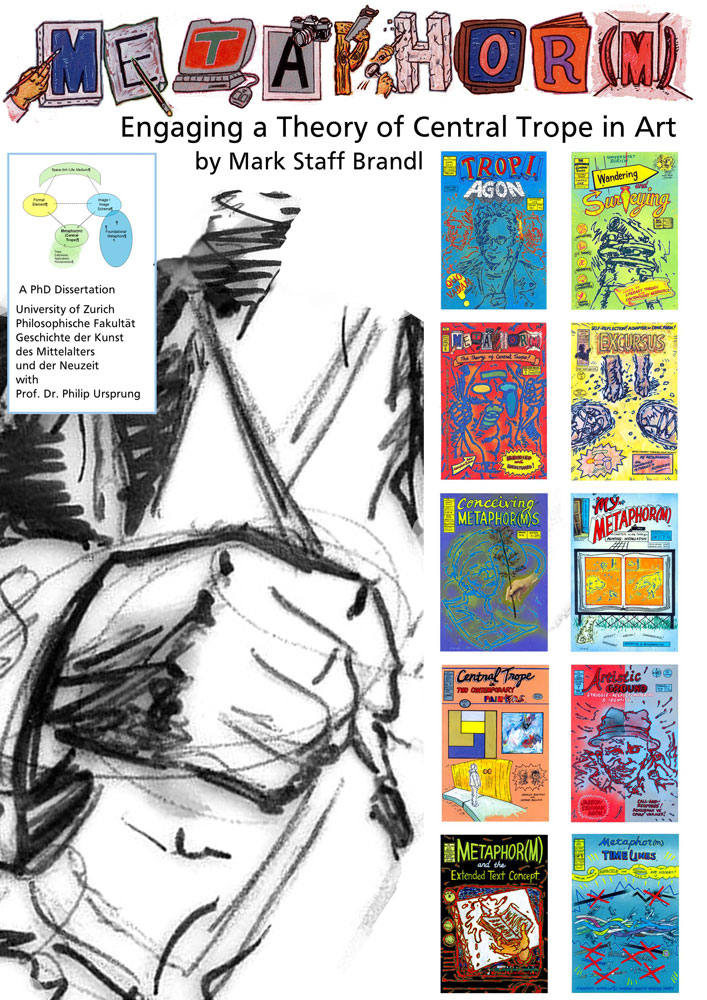Linking My Theory of Metaphor(m) to Pragmatic Use
by Mark Staff Brandl

A theory is a picture of the world, one way to think about reality, a suggested method for seeing experience in that way. It suggests both is and is not, and even, I assert, should be and should not be. Artists can picture life particularly well, thus being implicitly theorists. Small changes in the pictures with which we think, in our metaphor base, the stuff of the creative arts, have major importance. The operations of extending, elaborating, composing and, most of all, questioning may seem slight tools, yet they can build impressive edifices of understanding. Metaphor theory in general and my metaphor(m) idea in particular point out some of the instantiations of this drive. Trope-as-reasoning links theorization and creativity to everyday thought on the one hand, and to revelatory ideation on the other.
An enclosed quotation is enlightening here. This is Bloom citing Emerson, adding framing comments which are equally important.
Emerson is totally Vichian when he identifies rhetoric and reality, in his late essay “Poetry and Imagination”:
For the value of a trope is that the hearer is one: and indeed Nature itself is a vast trope, and all particular natures are tropes. As the bird alights on the bough, then plunges into the air again, so the thoughts of God pause but for a moment in any form. All thinking is analogizing, and it is the use of life to learn metonymy.
What Emerson is not saying is that we are in the dungeon of language. Lacan asserts that “it is the world of words that creates the world of things,” and Jakobson, less figuratively, allows himself to insist that the poetry of grammar produces the grammar of poetry. Emerson, like all central poets, knows that the grammar of poetry produces the grammar of poetry, since poetry is a discursive and not a linguistic mode. Holmes remarked that “Emerson was eminently sane for an idealist,” and such sanity is eminently useful now in current discussions of the arts of interpretation.1
Equally resonant is Bloom’s typical lack of footnoting. He sees interpoetical, as opposed to intertextual, metaleptical analogizing as part and parcel of his own thoughts. Borrowed metaphors are reformed by the glass of one’s own fashion, thus becoming one’s own. He is scholar enough to name the people from whom he has borrowed, but artist enough to see no reason to make a specific roadmap to an idea’s “first” expression. This can be academically frustrating, yet yields an (I believe unconscious) unity of form and content — thus it is Bloom’s own metaphor(m). It assumes the visual, graphic presence of a double indentation when quoted by me, highlighting this trait.
My theory of metaphor(m), and the articles on this website, assert the preeminence of the search for meaning, through metaphoric creativity, in art. This is not an attempt to restore some imagined, missing hint of a purport preceding the created text or object. It is an affirmation of the quest for meaning as the central struggle in creativity. It is no longer viable to seek to discover some imagined intention of meaning — the artwork is the achieved meaning, through its metaphor(m). Each artwork is a complex of multiple meanings performatively embodied. Historical fact is a necessary and enlightening frame of reference to anchor finer associations; nevertheless what a creator principally intended is always for that specific object to exist. What all creators try to do can likewise be plainly described. They try to tell truths — with emphasis placed on the verb and the plural noun ending. Yet these simple-sounding essentials are the bases for immeasurably rich creations. There is no objectivity beyond this. In the same way, a purely subjective response is of little pragmatic value, only perhaps inadvertently as a direction for a viewer’s own thought or as a guide to the thoroughly perplexed. A theory of creative metaphoric thought cannot be wholly “objectivist,” “subjectivist,” intentional, structural, paralinguistic, deconstructive, biographical, and most of all not formalistic. Each of these methods of interpretation places the weight of the meanings in a text or art work in some imagined, abstracted camp far from home, or in some cul-de-sac of unrecognized catachresis. The greatest danger of theorists is that they tend to create situations wherein works of art are arbitrarily expurgated from any living process and from all contexts, (be they cognitive, historical, economic, or various others). As a practicing artist and art historian with strong analytic proclivities and the penchant to cerebrate, I have attempted to construct a theory in resistance to this, an anti-theory of sorts, if you will: one which emphasizes living process, personal struggle, cognition, agency and historical context.
Metaphor(m) is proposed as a general theory of trope in the arts. If this or any other hypothetical analysis of the arts is worthy of any serious consideration, it is in its usefulness for fuller understanding and criticism of the works before us: as creators, as perceivers and as creative perceivers. Interpretation should seek the transformative through two important questions. What does the act of interacting with this work allow me to discover in life? How does this change and improve experience, i.e. “reality?” Metaphor(m), the theory of central trope, is a theoretical and critical approach emphasizing allusiveness and playfulness within concrete perception, linking striven-for content, discovered form, antithetical historical and critical cultural awareness.
(I have outlined my theory in the past in various publications and will continue to delve into it in the future. A very short explanation is here.)
